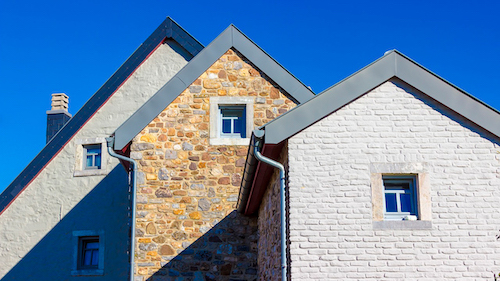Modern home design and construction have access to a huge variety of exterior finishing options. All these types of exterior finishes mean each home can be customized by selecting which materials give the desired aesthetic, durability, price, maintenance schedule, insulation, and environmental impact for the project. But with all the choices available, it can be a challenge to know the very best option for each specific project.
This article will explore more about what materials are available for external finishing and what things you should consider when deciding which is best for your application.

What Material Is Used for Outside Walls Framing?
There are many options for the finishing of the outside of a home; but before we get into those, let’s talk about what materials are used to create the frame of the building that those house exterior options will attach to.
Most commonly, house frames are constructed of either timber or steel. Timber framing is made from wood, a natural product that requires minimal processing, is sturdy, easy to work with, quick to assemble, and less expensive than steel. The downsides are that timber is: susceptible to pests, moisture, rot, and fire damage; can have naturally occurring imperfections; and changes over time with environmental conditions. Steel framing is: lightweight; able to be precision-machined and fabricated; less susceptible to environmental changes and pests; and recyclable. It does tend to be more expensive, however, and requires more energy and resources to manufacture.
There are other options for house framing, including block- or brick-built frames, concrete, and modular framing systems. These can work well also, but are less commonly used in general.
What Material Is Used for Exterior Walls Finishing?
Once the material for framing the home is decided, it's time to look at modern cladding and modern exterior siding options. There are eight that are most commonly used today, each with specific pros and cons.
1. Wood Siding
- Pros: Aesthetically pleasing, natural material, long-lasting if maintained
- Cons: Requires regular maintenance, changes with climate conditions, can be expensive
2. Natural Stone Veneer
- Pros: Aesthetically pleasing, long-lasting, little maintenance needed
- Cons: Expensive, requires skilled application
3. Brick
- Pros: Aesthetically pleasing, fire- and pest-resistant, long-lasting, little maintenance needed
- Cons: Expensive, requires skilled application
4. Vinyl Siding
- Pros: Less expensive option, wide range of styles available, little maintenance needed
- Cons: Often considered less aesthetically pleasing, generally not as long-lasting, susceptible to mold, requires cleaning
5. Stucco
- Pros: Insulating, aesthetically pleasing, less expensive material, doesn’t change with heat
- Cons: Moisture issues from improper installation in wet areas, requires maintenance
6. Fiber Cement Siding
- Pros: Durable, insect-proof, rot-repellent, and fire-resistant, undamaged by UV exposure, low-maintenance
- Cons: Expensive, requires skilled application, needs occasional maintenance
7. Composite Siding
- Pros: Durable, insect-proof, rot-repellent, UV-resistant, maintenance-free
- Cons: Potential for color fading over time, eventual cracking possible, often considered less aesthetically pleasing
8. Aluminum Siding
- Pros: Insulating, lightweight, insect-repellent, rot-proof, UV-resistant, low-maintenance, paintable, recyclable
- Cons: Potential for color fading over time, can be dented or scratched, possibility for noise in high winds or high heat conditions
What Material Will Last the Longest in an Exterior Application?
With all the modern finishing options, people commonly wonder which is the longest lasting siding for homes. Here’s how each of the siding types stack up in terms of average life span under standard conditions.
- Wood and Aluminum Siding - 20 to 40 years
- Stucco - 50+ years
- Vinyl Siding - 60+ years
- Natural Stone, Composite, Fiber Cement, Brick - 100+ years
There are a variety of environmental factors that affect the durability of all these finishing options. Things like extreme temperatures, high rain or snowfall, exposure to sea spray, frequent high winds, and high UV exposure all affect the life expectancy of different materials slightly differently. This is why many builders like to work with experienced finishing suppliers who can offer consultations about the best finishes for an area.
What Is the Best House Siding Material?
Durability is certainly an important factor in deciding what materials are best for a home build. But there are other considerations that go into the decision, too. For many these include:
- Price - When considering house siding options, costs are often top of the list of concerns. Choosing a material that fits a project’s budget can be just as important as aesthetics and durability.
- Insulation - In areas with extreme temperatures—hot or cold—the insulation properties of the siding can have a big impact on the comfort and HVAC bills of the finished home. Wood, aluminum, stone, and brick have the highest R-value and offer the most insulation; but insulated vinyl siding is also popular and offers higher energy-efficiency than any of the others.
- Environmental Impact - Homeowners and home builders alike are becoming more concerned with the impact of their chosen building material on the environment. Deciding which is the “greenest” finishing material is complex, however. Wood siding is a natural, renewable material that is lightweight to transport, but it needs to be replaced more frequently. Metal siding can be recycled and lasts longer. Insulated vinyl can make a home more energy-efficient and is lightweight to move. Brick and stone are natural materials that last the longest, but use a lot of fuel to mine and transport.
ClarkDietrich: Finishing Solutions that Work
At ClarkDietrich, we know exterior finishing—no matter which material you choose. We’ve designed industry-leading innovations to address the biggest installation and durability concerns in modern home building. We work with contractors, building developers, engineers, and architects to help today’s buildings perform to tomorrow’s standards.
Browse our website today to see what we offer for interior and exterior framing and finishing, floor framing, clips, and accessories.